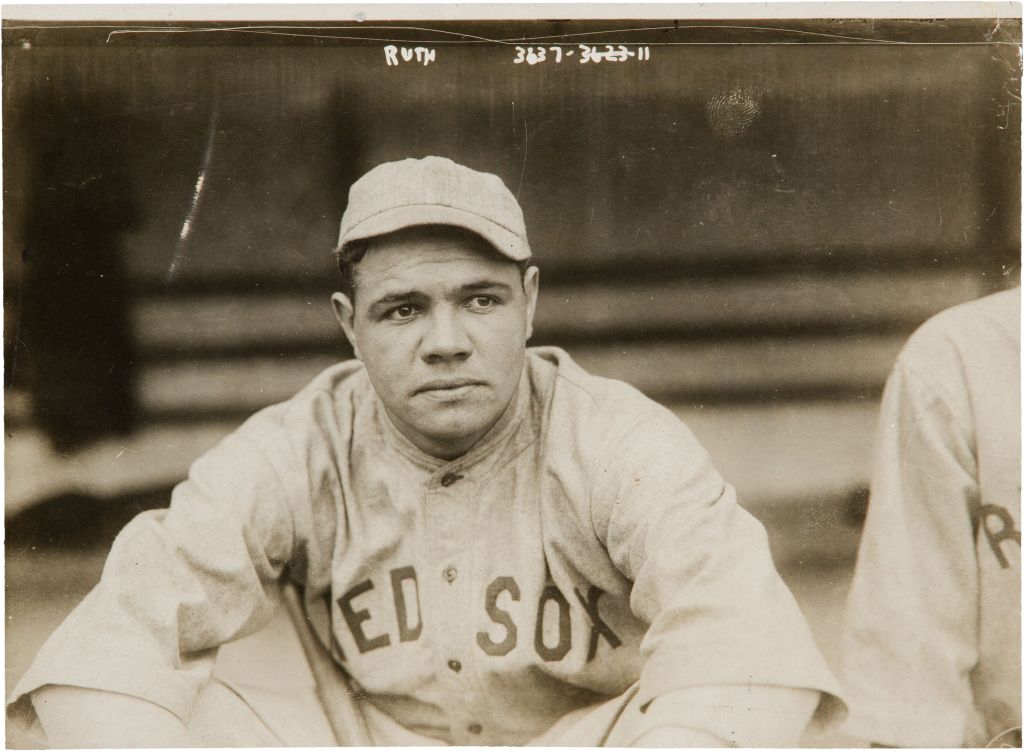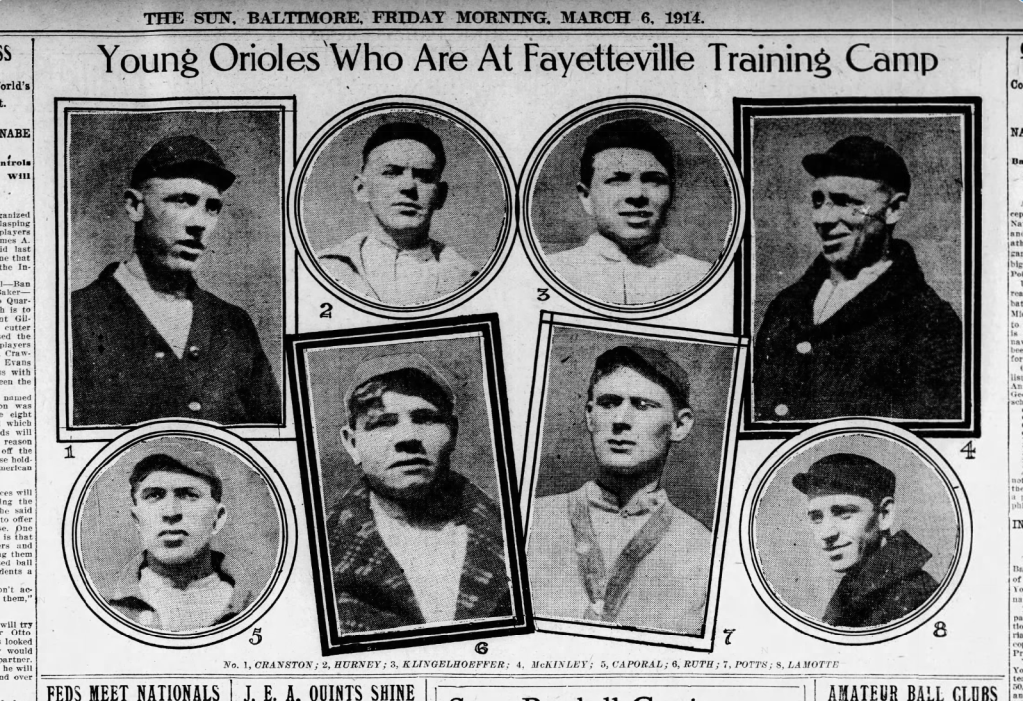Born: February 6, 1895
Died: August 16, 1948

Try and imagine (probably in black and white) a thin, young version of the Babe playing shortstop and ranging to his right or left to scoop up a ground ball … or running up and down the basketball court, dishing out assists. Hard as it may be to believe, these things happened. Turns our Ruth, well, the young Ruth, was a pretty good all-around athlete.
At the age of seven, Ruth was sent to live at the St. Mary’s Industrial School for Boys, a reformatory and orphanage. This is where he learned to play baseball and developed into an outstanding pitcher and hitter.
The Orioles … signed another local player yesterday. The new Bird is George H. Ruth, a pitcher who played with teams out the Frederick road. Ruth is six feet tall and fanned 22 men in an amateur game last season. He is regarded as a very hard hitter, so Dunn will try him out down South. The Baltimore Sun, February 15, 1914
Dunn was Jack Dunn, the owner/manager of the Baltimore Orioles, a minor league team that played in the International League. “Down South” refers to the team’s training camp in Fayetteville, North Carolina, where the team would head in early March.

The signing “sprung” Ruth from St. Mary’s and was the start of a career that would forever change baseball.
On March 4, 1914, the Sun reported “Ruth is trying out for the pitching staff, although he can play first base or the outfield.” The next day the Sun reporter wrote that “Ruth and [Chick] McKinley are attracting the attention of the fans here, these twirlers are beginning to cut the ball loose.”
The March 6, 1914, edition of the Sun featured photos of eight “Young Orioles Who Are At Fayetteville Training Camp.” Including Ruth. This might be the first photo of the Babe to appear in a newspaper …

Also on March 6, 1914, there was a story in the Sun about an exhibition game of basketball between players from the Orioles and a local high school. The Orioles won the low-scoring contest 8-6 and “Cottrell, Lidgate and Ruth starred for the Birds. These men had played basketball before and made some fine passes.”
GEORGE HENRY RUTH, of Baltimore, is 20 years old, weighs 185 pounds and is 6 feet 1 ½ inches tall. He is right-handed. Ruth is a single man. He played with Baltimore amateur teams last winter. The Evening Sun (Baltimore), March 7, 1914
Ruth was a lefty, and his middle name was Herman. He was not yet the Babe (the first story in which he was referred to as Babe Ruth was on March 28, 1914, in the Sun). How he got the nickname is a bit of a mystery. Some stories claim it was because he was so young, just a babe among men. Others say it’s because Dunn took him under his wing to the extent that the other players began to call him Dunn’s babe.
The Orioles played a 7-inning intersquad game on March 7, 1914. And Ruth “is credited with making the longest hit ever seen by Fayetteville fans … the youngster landed on a fast ball and circled the bases before Billy Morrisette had picked it up in deep field,” wrote the Sun. The story added that the monster shot broke the previous long-ball record set by non-other than the great Jim Thorpe. “The ball went far over Morrisette’s head and landed in a cornfield.”
Ruth pitched the final inning of the game and allowed one run. He began the game at shortstop and played the position “well, handling the three chances without a slip-up.”
On March 11, 1914, the Sun wrote about “Frank Ruth, the Baltimore sand-lotter …”
Soon, everyone would know the name Babe Ruth. But not quite yet. It’s surprising the paper got it wrong, as they’d gotten his name right several days in a row. I guess every reporter is entitled to an off day.
The same story added that:
Ruth made a fine impression upon Dunn. He was at St. Mary’s Industrial School for 14 years and played on the ball teams. Last fall Dunn was tipped off to the southpaw and visited the school and offered him a contract. Ruth signed without the slightest hesitancy. Several of the school’s players watched him as he penned his name to the document and one little fellow, who kept close tabs on the players, said: “Well boys, here goes our ball club.” Ruth … played every position. Several times he was forced to work double-headers, pitching the first contest and going behind the bat in the second. His batting won many games for St. Mary’s, his average last year being .537 … He is a well-built boy, having a broad chest and large muscles. He bats both ways. He tips the beam at 165 pounds and is down to his playing weight. The Evening Sun, March 11, 1914

It’s doubtful the Babe weighed 165 pounds in 1914. And, if Ruth was a switch-hitter at St. Mary’s, he immediately became a lefty-only batter with the Orioles.
More evidence of Ruth’s all-around baseball skills were written about in a March 14, 1914, story in the Sun that described how “playing at short Ruth covered lots of ground and took part in a fast double play.”
Ruth got his first real test on the mound on April 6, 1914, against the Brooklyn Dodgers of the National League in a preseason exhibition game in Baltimore. The Brooklyn Times Union reported …
The Dodgers were unable to do anything with the offerings of ‘Babe’ Ruth, who occupied the mound for the Orioles. Ruth had the big leaguers at his mercy and did not allow a hit until the fifth inning. Ruth is a youngster recruited from a local industrial school and it was his first real tryout. He had plenty of stuff and displayed an abundance of nerve and coolness while under fire.
On July 9, 1914, Ruth was sold to the Boston Red Sox of the American League along with pitcher Eddie Shore and catcher Ben Egan.
The Boston Globe wrote that Ruth already had “nine straight victories [for the Orioles] before the season was barely two months old” and that …
… seven big league clubs have made overtures for him, but until today Manager Jack Dunn of the Orioles persistently refused to dispose of him … Ruth is a strapping fellow and has just rounded out his 20th year. He has an inexhaustible supply of stamina, can wield a bat like an outfielder, and as a pinch hitter was one of the best the Baltimore fans ever saw. His chief stock in trade [as a pitcher] is speed, but he also has a sharp-breaking curve and a tantalizing slow ball.
The Babe had officially arrived. He won his first game as a pitcher two days later, July 11, beating Cleveland 4-3. He hit the first of his 714 home runs on May 6, 1915.
If you found this story interesting, you might like to read my From Unknown to Famous stories about Ernest Hemingway, Marilyn Monroe, Amelia Earhart, Jackie Robinson, Elvis and Alex Trebek. Please subscribe to this blog and get alerts every time I post a new one (lots more are coming).
